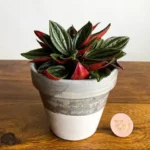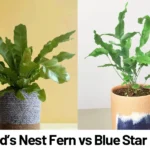Epipremnum aureum ‘Njoy’: A Guide to Growing This Stylish Variegated Vine Indoors
Epipremnum aureum ‘Njoy’, pronounced “Enjoy”, is a captivating variegated cultivar of the common pothos, beloved by houseplant enthusiasts for its compact growth and eye-catching white and green foliage. Perfect for beginners and experienced indoor gardeners alike, ‘Njoy’ is low-maintenance yet offers rewarding lushness when grown under the right conditions.
In this care guide, we’ll explore everything you need to know about growing Epipremnum aureum ‘Njoy’ indoors—lighting in lux, watering schedules, temperature and humidity needs, common issues, and more. Whether you’ve just picked up this plant or are considering adding it to your collection, this post will set you up for success.
Background and Botanical Overview
Botanical Classification:
- Botanical name: Epipremnum aureum ‘Njoy’
- Family: Araceae (Arum family)
Origin and History:
Originally discovered as a natural mutation of Epipremnum aureum (commonly known as golden pothos) in India, ‘Njoy’ was selectively cultivated for its striking white-and-green variegation and smaller leaves compared to its parent plant. Unlike wild Epipremnum aureum, which is native to the understories of tropical forests in French Polynesia, ‘Njoy’ is a cultivated hybrid, not found in the wild.
The parent species, E. aureum, was previously known under various synonyms including Scindapsus aureus and Pothos aureus, and has become a staple of interior plant design due to its tolerance for a wide variety of growing conditions.
Lighting Requirements (Measured in Lux)
Light is arguably the most critical factor for the variegation and overall health of your ‘Njoy’. This variety has less chlorophyll due to its white variegation, so it requires more light than non-variegated pothos to photosynthesize efficiently.
Recommended Lighting Ranges:
- Optimal growth: 10,000–20,000 lux (bright indirect light, east- or west-facing window)
- Sufficient for survival with slow growth: 5,000–10,000 lux
- Minimal survival threshold: 2,500–4,000 lux (expect leggy and pale growth)
Grow Lights:
If your home doesn’t meet the above lux levels, supplemental lighting through full-spectrum LED grow lights is highly effective. A 20W LED panel placed about 30 cm (12 inches) above the plant can provide around 10,000 lux—ideal for compact, healthy foliage.
Watering: Frequency and Factors
Unlike succulents, Epipremnum ‘Njoy’ enjoys moderately moist soil but is susceptible to root rot from overwatering. Here’s how to water properly by observing environmental conditions:
General Watering Guidelines:
- Spring–Summer (active growth): every 7–10 days
- Fall–Winter (dormant season): every 14–21 days
Adjust Based On:
- Pot size: Smaller pots (10–15 cm) dry faster — may need watering every 5–7 days in warm conditions.
- Humidity: Lower humidity increases evaporation. If RH < 40%, check soil more frequently.
- Soil type: Use a well-draining mix with 50% perlite or orchid bark to prevent waterlogging.
How to Water:
- Insert your finger up to the first knuckle — water only if the top 2–3 cm of soil feels dry.
- Water deeply until excess drains — never let the pot sit in water.
Temperature and Humidity
Epipremnum aureum ‘Njoy’ thrives in warm, humid environments but can adapt to standard indoor conditions if extremes are avoided.
Temperature Range:
- Optimal: 18–29°C (64–85°F)
- Minimum survival: 10°C (50°F) — prolonged exposure may result in leaf drop
Relative Humidity (RH):
- Ideal: 50%–70%
- Minimum: 40%
If your home’s humidity drops in winter, consider grouping plants together, using a pebble tray, or running a humidifier.
Common Problems and Solutions
1. Brown Leaf Tips
Cause: Low humidity or salt buildup
Fix: Increase humidity; flush soil monthly with distilled water to remove salts.
2. Yellow Leaves
Cause: Overwatering or poor drainage
Fix: Let soil dry between waterings; ensure pot has drainage holes and a fast-draining soil mix.
3. Leggy Growth
Cause: Insufficient light (<5,000 lux)
Fix: Move closer to a light source or add a grow light.
4. Loss of Variegation
Cause: Low light conditions leading to increased chlorophyll production
Fix: Increase light exposure to at least 10,000 lux.
5. Pests
- Spider mites or thrips: Appear in dry air and poor circulation.
- Solution: Wipe leaves with insecticidal soap weekly for 2–3 weeks and increase humidity to above 50%.
Safety and Toxicity
Toxic to pets and humans: Yes. Epipremnum aureum species, including ‘Njoy’, contain insoluble calcium oxalates which can cause irritation, swelling, and vomiting if ingested by cats, dogs, or small children (ASPCA, 2023). Keep out of reach or consider safer alternatives if necessary.
Useful Tricks for Real-Life Plant Care
- Sticky note irrigation trick: Stick a small note on the pot with your last watering date and next check-in reminder. Great for forgetful plant parents.
- Rotate every 1–2 weeks: Gives even light exposure for symmetrical growth.
- Use clear nursery pots: Allows you to check root health and moisture visually before watering.
- Propagate during repotting: Snip a stem with 2–3 nodes and root in water before transferring to soil.
Conclusion
Epipremnum aureum ‘Njoy’ is not just another pothos—its crisp variegation and compact structure make it a stylish and manageable houseplant for modern homes. With light levels in the range of 10,000–20,000 lux, moderate humidity, and careful watering, it rewards caretakers with vibrant, marbled foliage year-round. Though it is hardy and forgiving, attention to details like light intensity and humidity can elevate this plant from surviving to thriving.
If you’ve struggled with other variegated plants, ‘Njoy’ might be your perfect botanical companion. Keep it in bright spaces, watch the water intake, and remember—less is often more in plant care.
References
- American Society for the Prevention of Cruelty to Animals (ASPCA). (2023). Toxic and Non-Toxic Plants List. Retrieved from https://www.aspca.org/pet-care/animal-poison-control/toxic-and-non-toxic-plants
- Cleveland Clinic. (2022). Houseplants: How to Care for Pothos. Retrieved from https://health.clevelandclinic.org/how-to-care-for-your-pothos-plant
- Weidner, K. (2021). Pothos Plant Care Guide. University of Florida IFAS Extension. Retrieved from https://gardeningsolutions.ifas.ufl.edu








